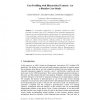Free Online Productivity Tools
i2Speak
i2Symbol
i2OCR
iTex2Img
iWeb2Print
iWeb2Shot
i2Type
iPdf2Split
iPdf2Merge
i2Bopomofo
i2Arabic
i2Style
i2Image
i2PDF
iLatex2Rtf
Sci2ools
CONTEXT
2007
Springer
2007
Springer
User Profiling with Hierarchical Context: An e-Retailer Case Study
In e-commerce applications, no systematic research has been provided to evaluate if the use of a detailed and rich contextual representation improves the user modeling predictive performances. An underestimated issue is also evaluating if context could be inferred by existing customer data off-line, in spite of getting the customer involved on-line in the gathering process. In this paper, we address those problems, defining context as “the intent of” a customer purchase. To this aim, we collected data containing rich contextual information, hierarchically structured, by developing a special-purpose browser. The experimental results show that the finer the granularity of contextual information the better is the modeling of customers’ behavior. Representing the context in a hierarchical structure is a necessary condition, for inferring the context off-line, but it’s not a sufficient one.
CONTEXT 2007 | Contextual Information | Customer Data Off-line | Information Management | Rich Contextual Representation |
| Added | 07 Jun 2010 |
| Updated | 07 Jun 2010 |
| Type | Conference |
| Year | 2007 |
| Where | CONTEXT |
| Authors | Cosimo Palmisano, Alexander Tuzhilin, Michele Gorgoglione |
Comments (0)

